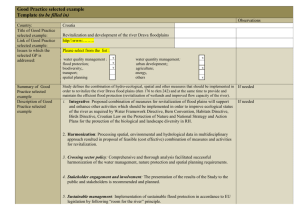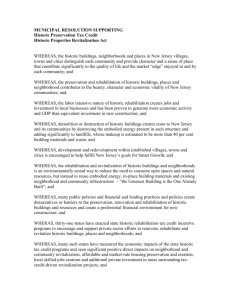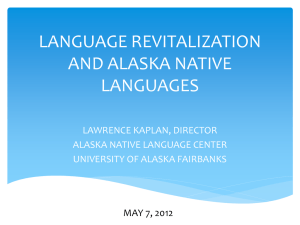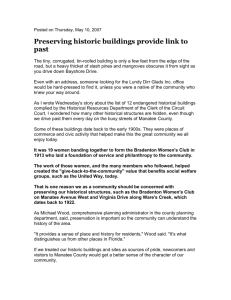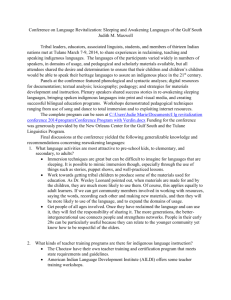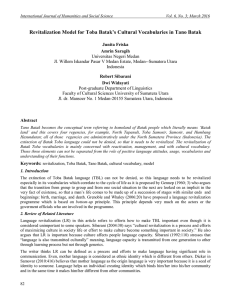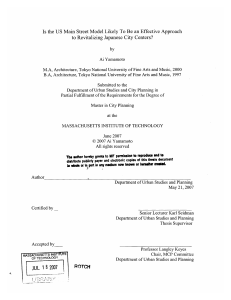Exhibit A Ten Criteria Explained
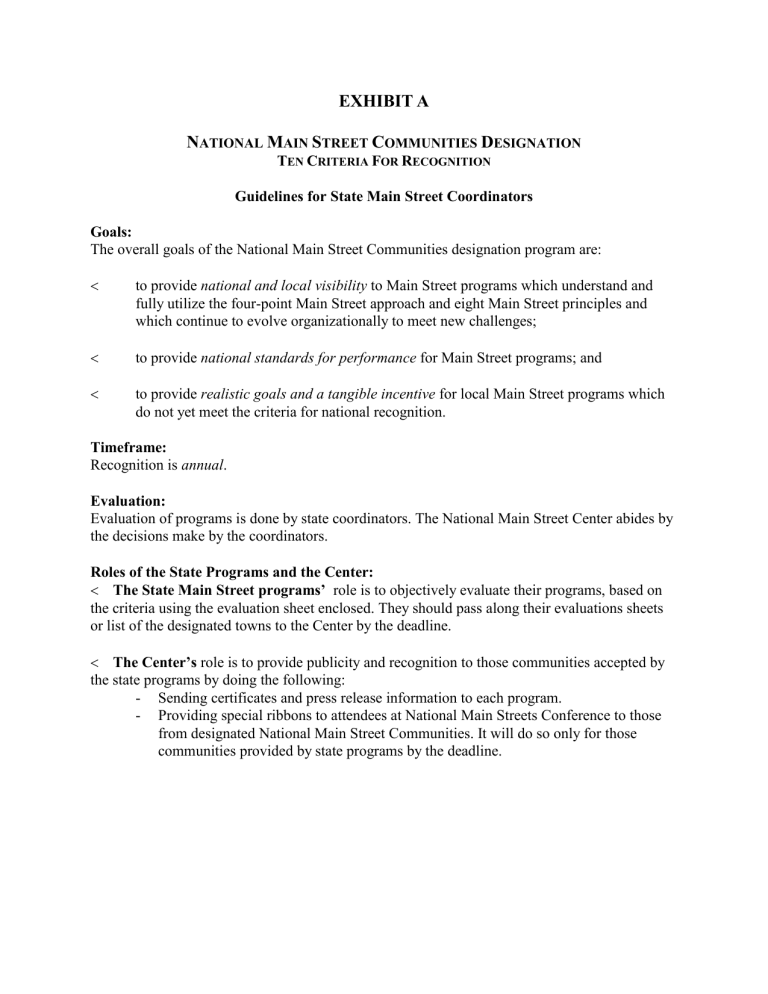
EXHIBIT A
N ATIONAL M AIN S TREET C OMMUNITIES D ESIGNATION
T EN C RITERIA F OR R ECOGNITION
Guidelines for State Main Street Coordinators
Goals:
The overall goals of the National Main Street Communities designation program are:
to provide national and local visibility to Main Street programs which understand and fully utilize the four-point Main Street approach and eight Main Street principles and which continue to evolve organizationally to meet new challenges; to provide to provide national standards for performance for Main Street programs; and realistic goals and a tangible incentive for local Main Street programs which do not yet meet the criteria for national recognition.
Timeframe:
Recognition is annual .
Evaluation:
Evaluation of programs is done by state coordinators. The National Main Street Center abides by the decisions make by the coordinators.
Roles of the State Programs and the Center:
The State Main Street programs’
role is to objectively evaluate their programs, based on the criteria using the evaluation sheet enclosed. They should pass along their evaluations sheets or list of the designated towns to the Center by the deadline.
The Center’s
role is to provide publicity and recognition to those communities accepted by the state programs by doing the following:
Sending certificates and press release information to each program.
Providing special ribbons to attendees at National Main Streets Conference to those from designated National Main Street Communities. It will do so only for those communities provided by state programs by the deadline.
Criteria:
The 10 criteria for recognition as a designated National Main Street Community are as follows:
1.
Has broad-based community support for the commercial district revitalization process, with strong support from both the public and private sectors.
Background: At its best, a local Main Street program represents and involves a coalition of organizations, agencies, businesses, and individuals from throughout the community -- not just those who own property or businesses in the commercial district or who have a direct economic tie to it, but all members of the community who are interested in the community’s overall health. Involvement by both the public and private sectors is critical, as well; neither sector can revitalize the commercial district without the skills and vantage points of the other. Ideally, both sectors will participate in the revitalization process by providing funding, leadership, and ideas, and by encouraging collaboration between existing programs to assist the revitalization process. By actively involving a broad range of interests and perspectives in the revitalization process, the Main Street program leverages the community’s collective skills and resources to maximum advantage. The overall goal is for a broad range of constituencies from both sectors to understand and be philosophically committed to the revitalization process and, to that end, to commit the maximum resources possible to achieve the goal of revitalizing the commercial district.
Guidelines:
The Main Street organization should have the active participation of various stake-holders at the committee and board levels, including such constituents as:
-- local government -- civic groups
-- regional planning groups
-- realtors
-- community development organizations
-- consumers
-- property owners
-- business owners
-- local industries
-- financial institutions
-- transportation authorities
-- developers
-- churches, temples, religious institutions
-- historic preservation organizations
-- school groups and students
-- architects and building contractors
-- parking authorities
-- district/neighborhood residents
Participants should contribute financial, in-kind, and volunteer support for the revitalization program.
Participants should also look for, and act on, opportunities to make connections between other programs with which they are involved and the Main Street revitalization effort so that, by doing their own work a little smarter, or in a better integrated way, other programs help further the revitalization process.
The program should include an ongoing process for volunteer recruitment, orientation and recognition, constantly refreshing its pool of volunteers and
involving new volunteers each year.
2.
Has developed vision and mission statements relevant to community conditions and to the local Main Street program’s organizational stage.
Background: A mission statement communicates the Main Street organization’s sense of purpose and overall direction. A vision statement communicates the organization’s longterm hopes and intentions for the commercial district.
Guidelines: Some revitalization programs begin with a vision statement; others develop a vision statement after several years of work. At a minimum , the Main Street organization should have a mission statement in place, reviewed annually (and updated, if appropriate). If the organization does not have a vision statement at the beginning of the revitalization process, it should develop one prior to the organization’s transition from the catalyst phase to the growth phase .
3.
Has a comprehensive Main Street work plan.
Background : A comprehensive annual work plan provides a detailed blueprint for the
Main Street program’s activities; reinforces the program’s accountability both within the organization and also in the broader community; and provides measurable objectives by which the program can track its progress.
Guidelines:
The work plan should contain a balance of activities in each of the four broad program areas that comprise the Main Street approach -- design, organization, promotion, and economic restructuring.
The work plan should contain measurable objectives, including time lines, budgets, desired outcomes, and specific responsibilities.
The work plan should be reviewed, and a new work plan developed, annually.
Ideally, the full board and committees will be involved in developing the annual work plan. At a minimum, though, the full board should adopt/approve the annual work plan.
The work plan should distribute work activities and tasks to a broad range of volunteers and program participants.
4.
Possesses an historic preservation ethic:
Background: Historic preservation is central to the Main Street program
s purpose. The historic buildings and public spaces of a traditional commercial district enrich civic life
and add value -- on many levels -- to the community. Developing a historic preservation ethic is an ongoing process of education and discovery for a community and for a local
Main Street program. Main Street programs which have embraced a strong historic preservation ethic are successful in saving, rehabilitating, and finding new uses for traditional commercial buildings and in intensifying the uses of the district’s buildings, through both specific building improvement projects and through policy and regulatory changes which make it easier to develop property within the commercial district. Some
Main Street programs purport to support preservation values, but do not fully understand that preservation is an ethic , not just an activity or group of activities .
Historic preservation involves not only the process of rehabilitating, restoring, or renovating older commercial buildings but also the process of adopting planning and land use policies which encourage full use of existing commercial centers before new development takes place, removing the regulatory and other barriers which sometimes make it difficult to attract investment to historic commercial districts.
Guidelines:
The program has, or is working towards putting in place, an active and effective design management program (which may include financial incentives, design assistance, regulatory relief, design review, education, and other forms of management).
The program encourages appropriate building renovation, restoration and rehabilitation projects.
The program works to find creative adaptive use, financing, and physical rehabilitation solutions for preserving old buildings.
The program recognizes the importance of planning and land use policies which support the revitalization of existing commercial centers and works towards putting planning and land use policies in place which make it as easy (if not easier) to develop property within the commercial district as it is outside the commercial district. Similarly, it ensures that financing, technical assistance and other incentives are available to facilitate the process of attracting investment to the historic commercial district.
The program builds public awareness for the commercial district’s historic buildings and for good design.
The program preserves more buildings than it demolishes.
5.
Has an active board of directors and committees.
Background: Main Street revitalization is an ongoing process of changing a community’s attitudes about its traditional commercial district (or districts). The direct involvement of an active board of directors and committees is key to this process. The Main Street
manager is responsible for facilitating the work of volunteers, not for single-handedly revitalizing the commercial district.
In some areas, and in communities of some sizes, local Main Street programs have been launched by or have merged with other organizations which have a broader agenda (such as a chamber of commerce or a community development corporation). A local Main Street program in one of these circumstances has a better chance of long-term success if it maintains focus on its particular purpose and if its mission statement, work plan, budget, and governing body remain distinct from that of the larger organization in which it is contained.
Guidelines:
The board is a working board, not “figureheads.”
Committees actively develop and implement the program’s annual work plan.
The Main Street program has a dedicated governing body and its own rules of operation or bylaws, even if the Main Street program is a part of a larger organization.
The program provides ongoing training for board and committee members.
6.
Has an adequate operating budget.
Background: In order to be successful, a local Main Street program must have the financial resources necessary to carry out its annual and evolving program of work. The size of a program’s budget will change as the program matures (in its early years, it may need less money than in its growth years). Also, program budgets are likely to vary according to regional economic differences and community size.
Guidelines:
The Main Street program’s budget should be adequate to achieve the program’s goals.
The budget should be specifically dedicated for the purpose of revitalizing the commercial district.
The Main Street program’s budget should contain funds adequate to cover the salary and fringe benefits of staff; office expenses; travel; professional development; and committee activities.
The dollar amount that is “adequate” for a program budget may vary from region to region, depending on local costs of living, and may be different for small-town, mid-size, and urban Main Street programs. General guidelines for minimum operating budgets are:
-- small town programs: $20,000+ annually
-- mid-size community programs: $30,000-$60,000+ annually
-- urban neighborhood programs: $65,000+ annually
7.
Has a paid, professional program manager.
Background: Coordinating a successful Main Street program requires a trained, professional staff person. While Main Street managers come from a broad range of academic and professional backgrounds, the most successful program managers are those who are good communicators; who can motivate volunteers; and who have good project management skills, being able to keep the revitalization program’s many activities moving forward on schedule and within budget. In most instances, the Main Street program manager’s position is full-time (generally 40+ hours per week). In small towns without the resources to hire a full-time program manager, a part-time manager is usually acceptable (generally 20+ hours per week).
Guidelines:
The Main Street program manager should be paid a salary consistent with those of other community development professionals within the city, state or region in which the program operates.
The minimum amount of time the Main Street program manager works each week should be consistent with comparable Main Street programs in the city, state or region.
The program manager should be adequately trained -- and should continue learning about revitalization techniques and about issues affecting traditional commercial districts.
8.
Conducts program of ongoing training for staff and volunteers.
Background: In order to meet new challenges and ensure a strong organization, Main
Street program participants need ongoing training. Participants -- both staff and volunteers -- need different skills in different phases of the revitalization process; for that reason, the skills a program’s participants learn in the program’s catalyst phase are rarely adequate for the growth or management phases . As staff and volunteer turnover occurs, new staff members and new volunteers will need basic Main Street training. And, all program participants should stay current on issues that affect traditional commercial districts and on new revitalization techniques and models.
Guidelines : The local Main Street program develops local leadership capacity through such mechanisms as:
taking advantage of citywide, state, regional and national training opportunities;
making reference and training materials available locally -- and using them; and
providing/conducting training when appropriate, including annual Main Street
101 training, annual orientation for board members, and annual committee training.
9.
Reports key statistics.
Background: Tracking statistics -- reinvestment, job and business creation, and so on -- provides a tangible measurement of the local Main Street program’s progress and is crucial to garnering financial and programmatic support for the revitalization effort.
Statistics must be collected on a regular, ongoing basis.
Guidelines:
The program submits regular reports (either monthly or quarterly, as specified by the statewide or citywide Main Street program).
Baseline Data Should Include:
Net and gross new jobs
Jobs retained (annual measurement)
Net and gross new businesses
Business retained (annual measurement)
Number of building rehabilitation and new construction projects, and $$ invested
-- specify if rehabilitation tax credit is used
Number of public improvements projects, and $$ invested
Number of building rehabilitation projects
Number of new housing units created
-- specify if low-income housing tax credit is used
Number and value of property transactions
Overall assessed value of property within the district
Commercial rents, per square foot
(annual measurement)
(annual measurement)
10.
Current member of the National Trust’s National Main Street Network membership program.
Background: Participation in the National Main Street Network membership program connects local programs to their counterparts throughout the nation, providing them with valuable information resources.
Guideline:
Current membership in the National Trust’ s National Main Street Network
E:\Main Street\STATE\About DEMS\Ten Criteria Explained.doc

